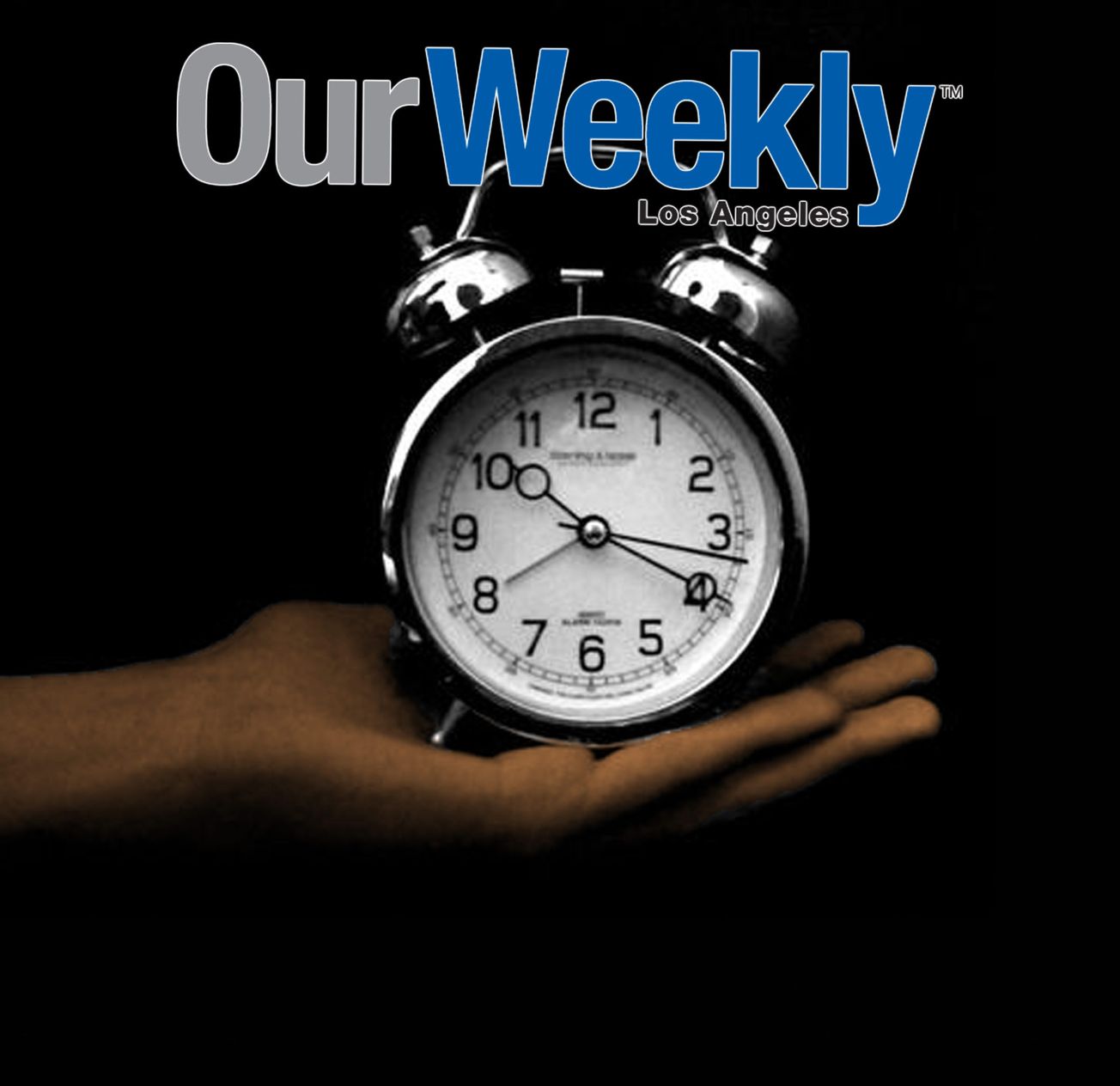Since its founding in 2004, OurWeekly covers have continued to provoke
thought. Last year’s editions featured the Biden-Harris team and their
inauguration, as well as a unique illustration contrasting Colin
Kaepernick’s taking a knee in protest of police violence and the knee of
George Floyd’s convicted murderer. It was quite an extraordinary 12 months. Please enjoy this recap of the year’s top cover stories.
In 2022, as OurWeekly celebrates its 18th anniversary, we look forward
to bringing readers a variety of additional, interesting news items and
engaging illustrations. All of the OurWeekly staff members wish you and
yours prosperity throughout the New Year!
America Under Siege
Jan. 14, 2021
BY GREGG REESE
OW CONTRIBUTOR
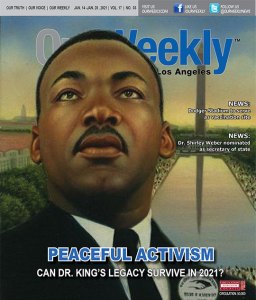
Here and now, more than 50 years after America’s proponent of peace was shot down, Martin Luther King’s bequest remains firmly in place while the war drums of intolerance rage around the world, especially in the country he was born and bred in.
The hue and cry to verify the latest Presidential election results (and the gathering of American lawmakers to undertake their due diligence) prompted another group (bonded by mutual feelings of oppression) to “seize the day,” and storm the grounds of the U.S. Capitol on Jan. 6.
The Capitol building has an interesting, Afro-centric history behind it. Like much of our nation’s capital, it’s construction was largely the result of Black labor including a little known (enslaved) sculptor’s apprentice Phillip Reed, who completed the casting of the 19 foot bronze “Statue of Freedom” which sits atop the dome of the building.
During the Civil War, Washington, D.C. was nestled between the Confederate enclaves of Maryland and Virginia (and 95 miles from the Rebel capital of Richmond). But aside from an audacious (but futile) charge by Gen. Jubal Early in 1864, the southern upstarts never came near it. Last week’s breach of the Capitol building security is thus significant for another reason: It is the first time the Confederate battle flag (alternately known as the stars and bars) has appeared in the nation’s legislative hub.
These events invited comparison to another march/protest by others on the opposite end of the political spectrum, Black Lives Matter (BLM). Enraged by the (lack of) response to the killing of George Floyd by police, scores of protests were held across the country, most tellingly, one on June 2, 2020 in Washington, D.C. (this time at the Lincoln Memorial).
In that event, police used tear gas and rubber bullets to clear crowds in preparation for President Donald J. Trump’s photo opportunity in front of St. John’s Episcopal Church.
In the words of BLM founder Melina Abdullah, a professor at Cal State Los Angeles, Trump then “sicced” the police (and over 4,000 members of the National Guard) on the nonviolent demonstrators.
In the aftermath of last Wednesday’s installment, scores of news commentators, political pundits, and average Joes (including the President-elect) compared and contrasted the two scenarios to underscore the hypocrisy of the law enforcement and justice systems.
Historic start to the Biden administration
Jan. 21, 2021
BY LISA OLIVIA FITCH
EDITOR IN CHIEF
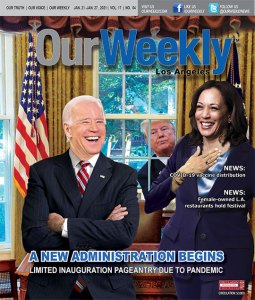
It was a different inauguration, unlike any that has been held in Washington D.C. There were no large crowds on the Capitol Mall, no parade down Constitution Avenue, and no former president to peacefully transition power.
The latter hadn’t happened since Andrew Johnson, another impeached president, decided to boycott the inauguration of Ulysses S. Grant.
Additionally, everyone on the Capitol stage had been tested for the coronavirus twice in those previous 72 hours. Including the supreme court justices, congressional members, three former presidents and their wives.
President Joe Biden, unlike his predecessor, has been in public service most of his life and served as a senator from Delaware for 36 years.
Finally, history was made at the swearing in ceremony of Vice President Kamala Harris, the daughter of immigrants whose mother often told her “Don’t sit around and complain about things. Do something.”
“This is a breaking of a glass ceiling,” one commentator noted.
The theme this year: “America united.”
The Rev. Leo Jeremiah O’Donovan III invoked the wisdom Solomon sought in his opening prayer.
“This is America’s day, this is democracy’s day,” Biden said during his speech. “Americans have been tested anew and America has risen to the challenge. Today we celebrate not the victory of a candidate but the victory of a cause.
“This is a great nation, we’re good people,” Biden continued. “A cry for racial justice some 400 years in the making moves us.”
The president referenced the moment Abraham Lincoln signed the Emancipation Proclamation and told his aides that he believed the document would be his legacy and that his whole soul was in it.
“My whole soul is in it,” Biden said. “My whole soul is in this uniting our nation and I ask every American to join me in this cause. We can do great things, important things.”
Mentioning the deadly coronavirus and the fight for racial justice several times in his remarks the President said “Our history has been a constant struggle between the American ideal that all are created equal, and racism…. that has torn us apart.”
But Biden is hopeful, and noted that Americans will need each other’s strength to make it through. He quoted Psalms 30:5: “Weeping may endure for a night, but joy comes in the morning.’”
Black immigrants and asylum in America
March 18, 2021
BY JOHN W. DAVIS
OW REPORTER
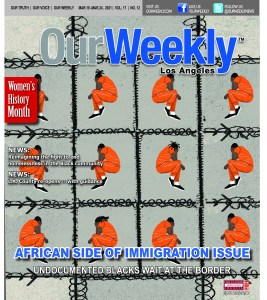
Ravi Ragbir is an immigrant from the Caribbean nation of Trinidad and Tobago who was deported from the United States during the Trump administration.
“No one should be deported,” said Ragbir, who is currently fighting his personal deportation case while serving as an immigration advocate and co-founder of the New Sanctuary Coalition. “I compare it to the fugitive slave act.”
Ragbir said he had a legal conviction, but believes he was deported primarily because he was advocating for immigration rights. He believes that the Trump administration ran a “campaign of terror” that discriminated against Black and Brown people.
Ragbir said he was surveilled, followed and targeted, along with about 1,000 other immigrants rights advocates across the country.
“We’ve been through four years of cruelty and chaos brought to you by the Trump administration,” said Frank Sharry, founder and executive director of America’s Voice, which is working to build a fair and equitable immigration system.
Sharry said Trump’s polarizing views may have excited his base, but the majority of America supports immigration reform after seeing children ripped away from their parents and people held in cages like stray animals.
“What does an immigrant look like,” questioned Patrice Lawrence, the co-director of UndocuBlack, a national network advocating for Black immigrants seeking asylum in the U.S.
Lawrence said it is important to note that there is an image of what an immigrant looks like and it is not a Black person. She believes “inherent bias” is at play when it comes to not giving Black immigrants the same considerations as other ethnic minorities.
Nearly 10,000 Liberians are eligible for green cards, but additional guidelines limited how many people could actually apply and be accepted, Lawrence said. (3,600 Liberians have already had their immigration status extended by President Biden to June 2022.) Lawrence said there are about 55,000 to 80,000 diversity visas
available on a yearly basis.
Notably, more than 60 percent of the people who receive diversity visas are from African countries. For immigration advocates, the Muslim and African immigration ban being rescinded is an important first step.
The LA County Library system is a committed online resource for obtaining US citizenship and temporary protected immigration status: https://lacountylibrary.org/citizenship/.
Tobacco industry cashes in on Black community’s menthol cigarette sales
March 24, 2021
BY LISA OLIVIA FITCH
EDITOR IN CHIEF

According to the American Lung Association, there are approximately 600 ingredients in a cigarette. When burned, that cigarette creates more than 7,000 chemicals and many of them are toxic, harming nearly every organ of the body, according to the Centers for Disease Control and Prevention (CDC). Asthma, cancer, diabetes, heart disease and vision loss are just some of the diseases/conditions associated with smoking.
In 2009, with a reference to his own struggles with a cigarette habit, President Barack Obama signed legislation bringing tobacco products under federal control for the first time. The Tobacco Control Act took most cigarette flavors off the shelves.
All except menthol.
Last year, Gov. Gavin Newsom signed Senate Bill 793 into law. This law was to be one of the country’s strongest restrictions on flavored tobacco and was supposed to go into effect on New Year’s day. But menthols are still on the shelf because the tobacco industry turned in enough signatures to call for a referendum of that law. Voters will decide whether or not to overturn SB 793 in November, 2022.
Detractors say SB 793 is racist and would criminalize merchants who sell to Black smokers, who prefer menthol. But Carol McGruder of the African-American Tobacco Control Leadership Council (AATCLC) believes the opposite is true.
“It was racist when they left menthol in the market,” she said. “Tobacco is preying on us.”
The CDC states that over 7 out of 10 African-American youth between ages 12 and 17 who smoke prefer menthol cigarettes. African-American adults have the highest percentage of menthol cigarette use compared to other racial and ethnic groups and tobacco use is the leading preventable cause of death for Black Americans.
“We are in profound historical pain,” said McGruder whose AATCLC partners with community stakeholders to influence the direction of tobacco policy. “Our lives have value. We are treated so indifferently.”
If cigarette sales are any indication, the pandemic seems to be making a difficult situation that much harder. After decades of consistent declines, cigarette sales held steady this past year. Studies show smokers and people who vape are at increased risk of developing chronic lung conditions which put them at a high risk for severe illness from COVID-19.
While thousands of Blacks have died during the pandemic, McGruder and her colleagues believe the time is now to tackle the tobacco issue.
“We have to walk and chew gum at the same time. We cannot wait.” she said. “Blacks live under tremendous stress and are self medicating with cigarettes. Tobacco control must be more relevant than ever.”
Christian courage and faith loom large in times of uncertainty
April 1, 2021
MANAGING EDITOR
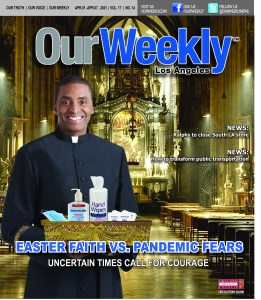
Courage is widely considered an indispensable asset for both spreading and preserving the truth. It takes great courage to remain steadfast in the teachings of Christ. Sometimes that philosophy may fall out of favor or be considered antiquated over the passage of time.
In the current pandemic, many African-Americans of faith may waver in their courage to be tested, to be vaccinated—or to endure an uncertain hospital stay if the infection turns worse.
Pastor James McKnight, lead pastor of the Congregational Church of Christian Fellowship in Los Angeles, refers those who may find their courage waining to 2 Timothy 1:7 — “God has not given us the spirit of fear, but of power, of love, and of a sound mind.”
“During difficult and uncertain times, God provides the answers, the courage and the resolve to remain confident that He is with us always and will not abandon us even in the most dire of situations,” McKnight explained.
The Bible emphasizes that another one of the greatest qualities we can possess is wisdom. The books of Proverbs and Ecclesiastes are replete with timeless advice, especially about the importance of wisdom — “The beginning of wisdom is this: Get wisdom. Though it costs all you have, get understanding (Proverbs 4:7).
King Solomon, with all his magnificent wealth and possessions, understood the value of wisdom: “For wisdom is better than rubies, and all the things one may desire cannot be compared with her” (Proverbs 8:11).
Wisdom helps us make wise choices. The effective outcome of responsible and sound choices and decisions are largely determined by the three crucial components of wisdom: knowledge, understanding and application.
During the pandemic, health officials have turned to the leaders of the Black Churches to inspire their congregations to participate in the testing and vaccination sites. As in most crises, it’s the Black church to the rescue, helping members to address their fears with wisdom and truth by consulting with physician congregants and reading through health department data.
Rev. Traci D. Blackmon, associate general minister of local church ministries with The United Church of Christ, believes that the pandemic—no matter how horrendous — may serve as a test of faith in allowing our reliance on God’s sovereignty to see us through the darkest of times.
“God provides a way through His words, through medical treatments and through doctors,” she said. “You may still have questions, and that’s okay.”
Bruce’s Beach: (Finally) doing the right thing
April 15, 2021
BY GREGG REESE
OW CONTRIBUTOR
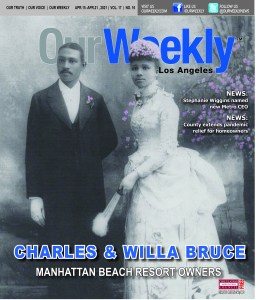
Eminent domain “appertains to every independent government. It requires no constitutional recognition; it is an attribute of sovereignty.” Boom Co. v. Patterson, 98 U.S. 403, 406 (1879). However, the Fifth Amendment to the U.S. Constitution stipulates: “nor shall private property be taken for public use, without just compensation,” according to the Department of Justice website.
In theory, the concept of eminent domain gives a political entity the right to appropriate private property for the greater good, usually for transportation (especially construction of the transcontinental railroad during the United States’ westward expansion), natural resources, or other projects deemed necessary for the betterment of the public.
An established beach haven for Blacks used to exist to the south in Manhattan Beach. It was called Bruce’s Beach.
In 1912, a “colored” couple Willa and Charles Bruce began buying property along the ocean to provide a resort (including a cafe, dance hall, and lodge). In turn they were joined by other “Negroes” who bought adjacent cottages in the approximately two block long stretch, establishing a community and safe haven from the segregated surroundings of the era.
Their neighbors responded by initiating a pattern of harassment including cross burning abetted by the Klu Klux Klan, before officials condemned the area and, citing eminent domain, seized the property under the pretext of using it for a public park.
The Bruce couple received $14,500 as compensation for land worth in excess of $100,000. The land lay vacant for decades, before a lifeguard station and training center was established. Today, houses within the area have a median value in excess of $6 million (according to the Redfin real estate brokerage company), and the land itself is a mega million dollar property.
Deprived of their birthright, family descendants today are scattered across the country, and the parcels they owned were passed on to the state in 1948, and by 1995 to the county.
Manhattan Beach has not assumed a reputation for racial harmony over the years. A Black family’s home was firebombed with a gasoline soaked tire as recently as 2015 (the investigation is still unresolved).
Four-year resident Kavon Ward enjoys the shops, restaurants, and other amenities in Manhattan Beach, but chafes under the realization that “…you’re not really wanted here.”
Ward organized a Bruce’s Beach protest last June. Upwards of a hundred ethnically diverse people marched from City Hall two blocks to the site of the former resort.
“(The) Manhattan Beach City council is useless,” she claims, singling out the exception of (Mayor Pro Tem) Hildy Stern, whose efforts to author a formal apology received no support. “They continue to choose money over morality and profit over people..”
Publicity has drawn attention to this controversy, and the office of Los Angeles County Supervisor Janice Hahn has become involved. She convened a press conference attended by several dignitaries near the site where the Bruce’s resort once stood. They announced the introduction of State Bill 796, the first step in allowing the County of Los Angeles to transfer the land to the Bruce family descendants.
George Floyd’s killer found guilty of murder
April 22, 2021
BY LISA OLIVIA FITCH
EDITOR IN CHIEF
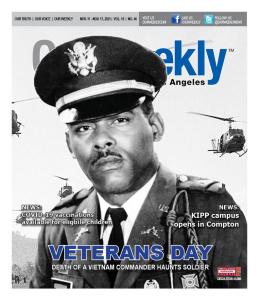
The jury listened to Monday’s closing arguments from prosecutor Steve Schleicher. He minced no words during the final moments of the trial against former Minneapolis police officer Derek Chauvin.
“Believe your eyes,” he told the jury, who had to view cell phone video and police body camera footage numerous times during the trial.
“What you saw happen, happened.” Schleicher told the courthouse members and the worldwide television public the specifics needed in order to convict defendant Chauvin of last year’s Memorial Day murder of George Floyd. Some specifics, as determined by the Minnesota justice system included: A proven death; that the defendant caused that death: and that the defendant committed felony-level assault by intentionally inflicting bodily harm.
“Unreasonable force, pressing him to the ground, that’s what killed him,” Schleicher said, later referring to the pulmonologist who testified to the cause of death earlier in the trial. “You don’t have to be Dr. (Martin) Tobin to see this.”
The prosecutor noted that the police officer’s compression of his knee to the neck and back of Floyd for more than nine minutes was unreasonable, causing asphyxia. Additionally, the fact that Chauvin seemed indifferent to Floyd’s plight, as evidenced by body camera audio and video footage, showed he had a disregard for life.
Even when his fellow officer suggested they roll Floyd onto his side to recover, Chauvin refused to comply. When it was evident that Floyd had passed out, Chauvin did not make any effort to use CPR.
“Officers are required to administer CPR,” Schleicher said. “He knew better, he just didn’t do better. He had the knowledge and had the tools.”
Schleicher also rebuked defense witnesses who claimed death could have been caused by a cardiac event, as Floyd had heart issues; that death could have been brought on by carbon monoxide poisoning, as his body lied near an automobile; or that there may have been a drug overdose.
All those questions were disproved by Schleicher and the experts he called to testify.
“Not enough oxygen could get to the lungs and that is what killed George Floyd,” he said, citing Chauvin’s tactic of restraint was not used by trained, reasonable officers. “It’s not procedure, it’s not use of force policy, it’s not the rules.”
The prosecutor insisted that death wasn’t caused by Floyd’s heart being too big, but it was caused because Chauvin’s heart was too small.
After less than 11 hours of deliberation, the jury found Chauvin guilty on all three counts: Second degree intentional murder; third degree murder; and second degree manslaughter.
“I’m feeling tears of joy,” Floyd’s brother Rodney said after the verdict. “So emotional. This right here is for everyone who’s been in this situation. For everybody. Everybody.”
Other speakers also noted that there have been many Black men and women in similar situations—abused by the authorities originally put in place to protect and serve. But this case had facts, video, medical experts and police witnesses for the prosecution—all which proved compelling. The jury held Chauvin accountable for what he did.
Many speakers noted that the nation’s African-American community had been through 400-plus years of oppression and still may have a long way to go, but the trial signaled a moment of transition. Although this trial was a micro-situation in Minneapolis, it had macro implications throughout the nation, in that it, in essence, bore the country’s reckoning with systemic racism.
Rising Black middle class creates gulf within community
May 6, 2021
MANAGING EDITOR
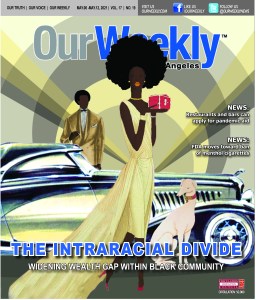
Long before he ascended to the Oval Office, former President Barack Obama addressed the 2004 Democratic National Convention and spoke of the ridicule Black students can receive from their peers because of educational attainment.
His wife, Michelle, years later addressed the derogatory nature of relating Black academic achievement to “acting White” in her 2013 commencement address at Boise State University. She called it “slander” in bringing to the forefront an ugly but not-so-secret byproduct of slavery: Intrarracial prejudice, loosely defined as “classism” and/or “colorism.”
Practically all African-Americans are familiar with derogatory racial terms and phrases such as “House Negro,” “Uncle Tom” or “oreo” in reference to others within the subgroup. Generations of Black sociologists have studied this intraracial discrimination as the remnants of “color codes” going back hundreds of years. This classification originally served as a basis for a hierarchy on slave plantations in which mulattoes and lighter-skinned Blacks found themselves in more “favorable” and privileged positions as opposed to darker-hued captives.
These distinctions exist today in regard to intraracial divisions, not only in skin tone but in education and family structure sometimes referred to as “borderism.” And it can bend both ways.
In Los Angeles, this dichotomy can be as banal as growing up or residing east or west of Crenshaw Boulevard. Following World War II, the vast majority of Black transplants to the City of Angels resided on the east side of town. It wasn’t by choice. It was a lawful application of segregation de facto. Over the past 75 years, many of those families who opted to move across town became engrossed in maintaining their newly-found middle-class status. Often, some of these households have neglected to “reach back” to whence they came and practice a mode of socioeconomic uplift aimed at their less-advantaged brethren.
Early in the 20th Century, Dr. W.E.B. DuBois advocated for a “Talented Tenth” of African-Americans who would become social leaders and, over time, would be in positions to lift up the Black community toward more productive and enriching endeavors. He also lamented the growing class divide within Black America and how the consequences of that chasm might affect the task of “lifting as we climb.”
Dr. William Julius Wilson, a famed Harvard University sociologist, concluded years ago that the problem of income inequality is not necessarily between Black America and White America but, rather, between Black “haves” and “have-nots.”
“The class divide is one of the most important and often overlooked factors in the rise of the Black Lives Matter movement,” suggests Harvard University Prof. Henry Louis Gates Jr. He said he often hears from his students about a certain “pressure to rise” yet maintaining an obligation to look back to lift others.
Black Star Collectibles in Carson: Capitalizing on Black pop culture
July 8, 2021
BY GREGG REESE
OW CONTRIBUTOR
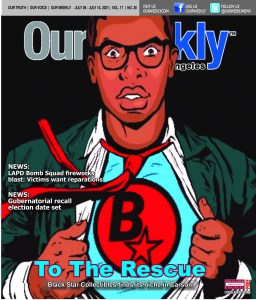
The fact that even the most jaded among us have vivid fantasies (that we may or may not admit to) doesn’t quite explain the popularity of SuperHero movies, but perhaps it gives a clue. The patronage of this genre is assuredly not limited to juvenile movie-goers, as a quick glance at box office lines will reveal patrons middle aged and above. Aside from being a harmless form of visual junk food, with little nutritional value in the form of deeper meaning or life lessons, these fanciful tales offer escapist melodrama played out by idealized beings possessing fantastical abilities that provide a respite from everyday life.
Of course, these fictional heroes have historically happened to be largely White.
Nearly everyone is predisposed to gravitate to images that look like them, and this is not necessarily evil in and of itself. This is true of the film and marketing executives who concoct the recreational materials offered up to the teeming masses eager for new and varied content.
Kindred spirits Feon Cooper and Kareem Burton separately attended Compton High and Dominguez High School respectively, but their paths crossed while attending Chester Adult School and they reconnected in 1995 when Burton secured his first job during the home movie and video game craze then in vogue. Cooper soon followed him to NBA great David Greenwood’s Blockbuster franchise, and through the course of work and hanging out after hours, they bonded over the whole comic book/animation strata.
Both had dreams of becoming independent shop owners, and the reality of employment at a business owned by a person of color spawned the idea that they too, could become entrepreneurs.
Cooper’s first business venture materialized in 2010, when he opened his doors at Compton Boulevard and Burris Avenue. This attempt was not successful, and he shut down after a year. He cites a lack of Black heroes as a factor.
But “failure is not fatal,” as Winston Churchill once said.
The process of trying was in itself a learning experience, and four years later he started over, this time with a comic and toy store geared towards the general market in Long Beach’s Shoreline Village.
This lasted two years and did much better than his initial foray, but circumstances again forced him to close, not least being the cost of the lease.
“If you ever get a space that’s on the waterfront, you gotta pay for the waterfront,” Cooper said.
Thus fortified with additional experience, the entrepreneur shifted his strategy to downsizing, and procured a kiosk at ThePikeOutlets in Long Beach.
The third time was the charm, and with decent revenue rolling in, Cooper reunited with Burton and the duo revisited their original concept of an Afro-themed venue. Now the large and small screens were saturated with narrative stories featuring Black protagonists, including “Black Lightning” (the CW), “Black Panther” (Marvel Studios),“Luke Cage” (Netflix), and “Watchmen” (HBO).
“Once corporations found out they could make money off of this culture then it took away a lot of the barriers and it united people,” observes Burton.
“There are Black-owned comic shops, but there’s no pro-Black collector’s shops where the focus is mainly on Black pop culture. That’s what our store is about” said Cooper.
Visit Black Star Collectibles at 20700 South Avalon Blvd, Carson, CA 90746 in the SouthBay Pavilion, or go to: https://blackstarcollectibles.com/.
Critical Race Theory becomes latest political talking point
July 15, 2021
MANAGING EDITOR
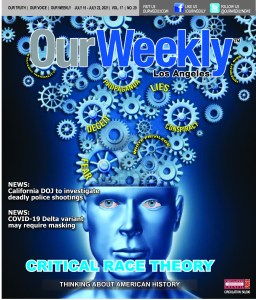
Today’s politically incendiary debate surrounding Critical Race Theory generally falls in line with the sordid yet signature history of American politicians using Black people for political gain. Both parties are guilty of this, be it for noble or nefarious reasons.
It’s as old as Aaron Burr accusing Thomas Jefferson during the 1800 presidential campaign of siring a stable of “Monticello mulattoes.” In 1860, the Republican Party made good on its vow to nominate and elect an anti-slavery president. Southern Democrats for the next 100 years would blame Abraham Lincoln for the resultant bloodletting.
In modern times, Hillary Clinton was accused of using racial divisiveness when she said that then-Sen. Barack Obama would be unable to win over the “hard-working Americans, White Americans” necessary to win the general election.
“The less people understand an issue, the more leeway there is for [politicians] to gin up controversy,” said Lisa Gomez, a law professor at UCLA. She co-founded the school’s Critical Race Theory program in 2000. At its core, she said, Critical Race Theory helps to identify this dynamic: “When the country takes two steps forward in the name of progress, racist forces push it a step back.”
Critical Race Theory is the latest political lightning rod. Almost overnight, the term seemed to appear in statehouses and at political rallies from coast to coast. In the last six months, it has morphed from an obscure academic discussion point on the left into a political rallying cry on the right.
Critical Race Theory is a way of thinking about America’s history through the lens of racism. Scholars developed it during the 1970s and ‘80s in response to what they viewed as a lack of racial progress following the Civil Rights Movement (and subsequent legislation) of the 1950s and ‘60s. It centers on the idea that racism is systemic in the nation’s institutions and that they function to maintain the dominance of White people.
Now the term has become a catchall phrase to describe racial concepts that some conservatives find objectionable (e.g. White privilege, systemic inequality, inherent bias).
Education Week conducted an analysis earlier this year and found that, so far, about 25 states have considered legislation or other steps to limit how race and racism can be taught. Eight states, all Republican-led, have banned or limited the teaching of Critical Race Theory or similar concepts through laws or administrative actions.
“Such bans are aimed at the lower grades, and are also being aimed at public colleges and universities,” said Dr. David Horne, founder and executive director of the Pan African Public Policy and Ethical Institute. A professor at Cal State Northridge, Horne once taught a graduate seminar on Critical Race Theory.
The real problem behind the political controversy, he said, is that “none of them seem to have a real clue as to what Critical Race Theory actually is.”
Some of the GOP-led bills specifically want to prevent the teaching of the New York Times’ 1619 Project—a sweeping collection of essays and literary works that center on Black American’s founding contributions to the country via slavery—which conservatives have scrutinized since it was originally published in 2019. Others reflect calls by former President Trump for “patriotic education” or instruction that doesn’t stray far from the traditional telling of American history.
In effect, the backlash against Critical Race Theory began in earnest last summer as the nation was trying to reckon with racism in the wake of the police killings of George Floyd and Breonna Taylor. Major corporations pledged not to be racist. The Mirriam-Webster dictionary even changed the definition of racism to include how it is systemic.
“‘Whites only’ signs are gone, but the racial power remains in a myriad of social practices,” said Gary Peller, a constitutional law professor at Georgetown University Law Center.
Changing the definition of success
Aug. 5, 2021
BY LISA OLIVIA FITCH
EDITOR IN CHIEF
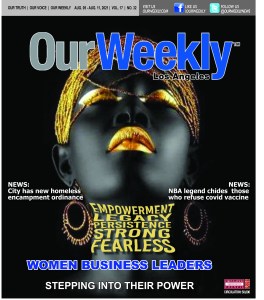
According to the U.S. Census Bureau surveys, women outnumber men in the country and in 2019, 33.9 percent of women 25 and older had earned bachelor’s degrees or higher, compared with 32.3 percent of men.
But according to the 2019 Annual Business Survey, only about 19.9 percent of all U.S. businesses were owned by women.
Institutional biases against women business owners were in solid existence until the 1988 passage of HR 5050, signed by then-President Ronald Regan. Among its many provisions, the new bill required the Census Bureau to report women-owned C-corporations when reporting data. It also eliminated state laws requiring women to have a male relative or husband co-sign a business loan.
Today, women are establishing businesses in a variety of industries, from beauty salons to construction companies. But according to a recent survey by the U.S. Chamber of Commerce, the number of female business owners who ranked their business’s overall health as “somewhat or very good” fell 13 points during the pandemic, from 60 percent in January to 47 percent in July 2020.
A March 2020 report for the Office of Advocacy U.S. Small Business Administration found that women continue to face different competing demands on their time than men, including a greater role in childrearing and home management.
Susan Dawson, chair-elect of the National Association of Women Business Owners (NAWBO) and a co-founder of the Chicago-based law firm, Waltz Palmer Dawson, notes that her members describe themselves as occupying three roles — business owner, parent and teacher — “with no break in sight,” Dawson said, speaking from experience.
“I figured out how to hardwire a router from my basement to my office just so that I can get online and do what I need to do for my business,” she said. “Now [my kids] need to be first in line, and I’m last for the Internet, because they have to go to school.”
Her husband is an essential worker.
“I’m struggling with being a mom and running a business and being a teacher,” Dawson said.
As the state entity tasked with assessing gender equity in multiple issue areas including health, safety, employment and education, the California Commission on the Status of Women and Girls is uniquely positioned to uplift local commissions and the direct service providers they work with to help ensure that women’s needs are centered in the statewide recovery efforts. There are 30 total local commissions on women in California at either the county or city level. The Commission seeks to build a more direct system of support for women in communities across the state.
“As we grapple with the long-term consequences of this pandemic, it is imperative that women across the state, in all industries and localities, receive the support they need,” the commission stated.
Climate change captures attention of African-American community
Aug. 19, 2021
MANAGING EDITOR
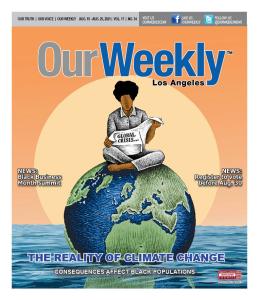
Over the past few years, opposing factions within American society have battled and grappled with everything from Black Lives Matter, police reform, the Me Too Movement, voting rights and institutional racism. Obviously, these issues relate primarily to African-Americans in a continued struggle for equity and the full complement of civil rights.
But there’s another issue that’s not always a “front-burner” topic among African-Americans, but merits immediate attention: Climate change is a calamity afflicting every continent, nation, locality and neighborhood. It’s more than mere theory or unsettled debate.
Last week, a science report from the United Nations’ Intergovernmental Panel on Climate Change said the world has rapidly warmed 1.1 degrees Celsius (33.98 Fahrenheit) higher than pre-industrial levels. The planet is careening toward 1.5 degrees warmer, a number said to be a critical threshold that world leaders at one point agreed should remain below to avoid worsening impacts.
The report, unlike previous assessments, concluded that it is “unequivocal” that humans have caused the climate crisis and confirms that “widespread and rapid changes” have already occurred—some of them irreversible.
Despite the myriad of fateful challenges that confront African-Americans, climate change has for years been a pressing life-and-death issue that has affected generations of the Black community.
About 15 years ago, the Congressional Black Caucus Foundation (CBC) issued the report “African-Americans and Climate Change: An Unequal Burden” that put a spotlight on hurricanes, “super storms,” environmental pollution and the many health maladies within the inner city resulting from left-over carcinogens from long-abandoned factories.
The majority of African-Americans reside in urban areas with a significant number scattered throughout the South. The combination of global warming, heatwaves and the “urban island heat effect” has rendered many Blacks at risk of suffering long-term health problems specifically as asthma relates to air pollution and lead poisoning is rooted in tainted water supplies.
Not long after the CBC report, the Environmental Justice and Climate Change Initiative found that heat-related deaths among Blacks occur at a 150- to 200-percent greater rate than for non-Hispanic Whites. Cities, they found, tend to have more air pollution and smog—which leads to an array of upper-respiratory health concerns. The American Lung Association reports that African-Americans are three times more likely to die from asthma-related causes than the White population.
In Southern California, bigger and increasingly ferocious wildfires permeate the Los Angeles Basin with poisonous particles stretching from the sunny shores of Malibu to the mean streets of Watts on an alarmingly frequent basis.
In the era of climate change, cities are expected to warm faster with greater density than rural areas. The high temperatures increase the risk of respiratory problems, heat-related stress and other illnesses. A 2014 report from the Center for American Progress found that 72 percent of African-Americans reside in counties that violate federal air pollution standards. This is in comparison to 58 percent of White persons.
Climate change exacerbates existing socioeconomic inequalities. Research conducted by the Center for Climate Change Communication found that African-Americans are more concerned than Whites about climate change because they are often more exposed and vulnerable to environmental hazards and extreme weather events. Blacks (and people of color in general) are more likely to be exposed to air pollution. The report suggested that inequitable exposure to environmental problems could explain why an increasing amount of African-Americans report greater intentions to engage in climate activism.
Charles Drew University is fulfilling its wildest dreams
Sept. 2, 2021
BY JOHN W. DAVIS
OW REPORTER
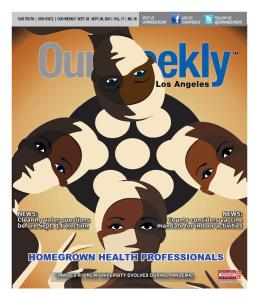
It was always a dream that Charles R. Drew University of Medicine and Science (CDU) would reach new heights. Simply put, the time is right for change across America, in particular at CDU.
During the COVID-19 pandemic, community outreach became the utmost focal point for the university.
“Our vaccination strategy for the general population in California has been a big success,” said Dr. David M. Carlisle, CDU’s CEO and president.
During the pandemic, CDU has received several grants, totaling nearly $70 million, which will fund exponential growth at the school’s campus in Willowbrook. Carlisle said funding began pouring in after former presidential candidate Michael Bloomberg invested $6.5 million to reduce the debt burden of graduates from CDU’s medical school.
Meanwhile, earlier this summer, Carlisle said with the help of Assemblymember Mike Gipson (64th District) and State Sen. Steve Bradford (35th District), Gov. Gavin Newsom’s new fiscal budget set aside $50 million dollars to construct a new state-of-the-art building on CDU’s campus to house the university’s new four-year MD program.
Most recently, the university has received $12 million dollars from the federal government’s CARES Act relief fund program to ultimately increase the number of Black health professionals.
“I’m tremendously excited by the economic potential that these dollars bring to South Los Angeles. In the case of the state funding, that’s $50 million dollars that will be injected into South Los Angeles. Construction jobs, employment in the medical school. That’s all money that we’re happy to bring to our community.”
Founded in 1966, CDU is nationally recognized as one of the only Historical Black College and Universities (HBCUs) specializing in medical education.
“It’s a dream that’s been deferred,” said Sylvia Drew Ivie, the special assistant to the president for community affairs, who is the youngest daughter of the school’s namesake. “To really realize a whole breadth of possibilities of the university. We have never gotten this level of financial support or this level of recognition, nationally, state-wide and locally that we’re now enjoying.”
CDU is named after Dr. Charles R. Drew, a distinguished African-American physician who was a pioneer in medicine in the early and mid-20th century. Drew’s work on blood banking and blood plasma storage and transfusion, coupled with his ability to overcome racism, placed him as a distinguished surgeon and the chair of surgery at Howard University. Although Drew died in 1950, his legacy of working to eliminate health disparities in all communities is especially relevant today.
When CDU’s new medical programs are built out, it will have a direct impact in South LA. It will mean additional local Black doctors and nurses, which Carlisle hopes will holistically improve the level of care many currently receive in Black and Brown communities.
“It will have a transformative effect on the presence of health professionals in under-resourced communities.” Carlisle said.
Tuesday recall election to determine future governor of California
Sept. 8, 2021
BY LISA OLIVIA FITCH
EDITOR IN CHIEF
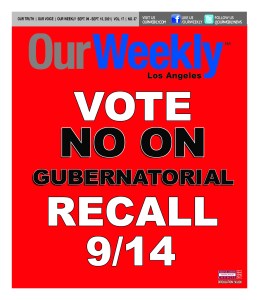
The federal Voting Rights Act of 1965 is under fire, as many African-Americans are being cheated out of their right to vote in Republican-led states. Voting is a basic, American right for which many Black ancestors fought and died.
Supporters of Gov. Gavin Newsom say it is especially important to raise everyone’s voting voices regarding the Tuesday, Sept. 14 election, as conservative Republicans who seek the governor’s recall want to take California in a different direction.
Even though Newsom has been a pioneer on same-sex marriage, gun safety, marijuana, the death penalty, universal health care, access to preschool, technology, criminal justice reform, and the minimum wage, and his policies were ultimately, embraced and replicated across the nation, he faces opposition members who want to turn California into a red state.
According to California Black Media, the state currently has the largest economy in the country and a budget surplus of $75.7 billion under Newsom’s leadership.
The governor issued the first statewide stay-at-home order in the nation, and his policies kept most public school students at home last year. Newsom has required all health care workers to get fully vaccinated by the end of the month.
The governor has said his policies are driven by science, but they have helped land him in an unexpectedly competitive recall election.
California has not elected a Republican governor since Arnold Schwarzenegger won in a 2003 recall election.
White House press secretary Jen Psaki said Tuesday that President Joe Biden will visit California on behalf of Newsom early next week. His trip comes after other top Democrats, including Sen. Elizabeth Warren of Massachusetts and Sen. Amy Klobuchar of Minnesota campaigned for Newsom over the weekend and as Vice President Kamala Harris campaigned in the Bay Area for Newsom on Wednesday.
“While extremists push for a sham recall election in California, extremists like Marjorie Taylor Greene and Josh Hawley are spreading misinformation about COVID-19, the 2020 election, and President Joe Biden,” said Rep. Karen Bass (D-37). “It’s clear that we are still living in Trump’s America.”
Breast cancer among Black women continues to rise at alarming rate
Oct. 7, 2021
MANAGING EDITOR
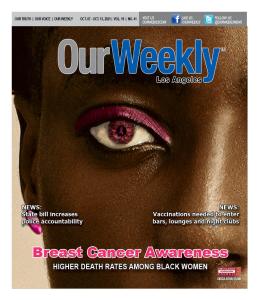
With October serving as Breast Cancer Awareness Month, breast cancer continues to be the most commonly diagnosed cause of cancer deaths among U.S. women. Compared with White women, Black women historically have had lower rates of breast cancer incidence, but during the 1980s, it was found that they had higher death rates.
Researchers have been aware of the disparity for decades, but it has resisted easy explanation. The stakes are higher today. During the period between 2010 and 2015, for instance, the Centers for Disease Control and Prevention (CDC) found that approximately 221,000 breast cancers were diagnosed each of those years. The overall incidence of breast cancer was similar among Black women (121.5 cases per 100,000 population) and White women (123.6 cases per 100,000 population), but differences by age and stage were found. Compared with White women, breast cancer incidence was higher among Black women aged 60 years, yet lower among Black women less than 60 years of age.
The five-year time frame also found that breast cancer mortality was 41-percent higher among Black women (29.2 deaths per 100,000 population) than White women (20.6 deaths per 100,000 population). Overall, through better outreach and messaging, the diagnosis of breast cancer has actually decreased among all women, but the mortality rate has decreased significantly faster among White women.
“For years people have talked about the disparities and suggested we just need to get more Black women screened. Yet in most cases, Black women are getting screened at higher rates than White women, and they are dying more often,” said Paula Schneider, president and CEO of Susan G. Komen. “The disparity is not a simple matter of access to screening—it is a perfect storm of issues that have been brewing for a long time and span across every aspect of the healthcare system and society at large.”
Breast Cancer Prevention Partners, a national science-based policy and advocacy organization, has listed a series of possible causes for the high mortality rate among Black women. It’s an unexpected inventory of products specifically marketed to Black women which may (or may not) contribute to the disease, including: Skin lighteners, nail polish products and treatments, hair relaxers and fragrances.
Soldier, Statesman, American
Oct. 21, 2021
BY GREGG REESE
OW CONTRIBUTOR
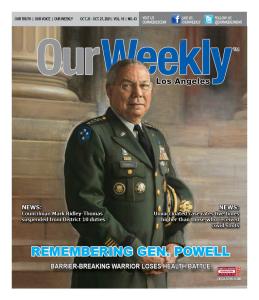
The coronavirus (COVID-19) has taken yet another life, one notable outside the 700,000+ so far. Gen. Colin L. Powell succumbed to complications from the disease on the morning of Oct. 18, his family announced on his Facebook page.
“We have lost a remarkable and loving husband, father, grandfather and a great American,” the statement read.
Powell, who had been treated at Bethesda, Md’s Walter Reed National Medical Center for blood cancer, was 84 years old. He became the first of his race to head up the Joint Chiefs Staff as well as serving as the Secretary of State. He attained these positions through his ability to garner the respect of both the Republican and Democratic sides of America’s political divide.
The soldier and statesman displayed no potential for greatness early on. The offspring of Jamaican immigrants, he was born in April 1937, and grew up in the New York borough of the South Bronx.
Colin demonstrated no exceptional skill academically or athletically until he enrolled at the City College of New York (CCNY), where he pledged a campus ROTC society, and discovered a knack for military drill and ceremony. The structure and regimentation awakened something within the aspiring soldier, and in short order after receiving his degree in geology in 1958, he was commissioned as a second lieutenant in the U.S. Army.
Postings in Germany, then at Ft. Devens, Mass., were significant because he received his first company commands. More tellingly, a blind date yielded an introduction to a well-bred southern belle from one of the leading Negro families in Birmingham, Ala.
Alma Johnson was a Fisk University graduate who’d come to Boston for training in audiology while moonlighting as a radio show host. In short order, the new couple became inseparable, engaged, and were wed in August of 1962, less than a year after meeting the previous November.
Now a Captain, Powell won a Bronze Star and a Purple Heart for wounds sustained in Vietnam combat. Upon his return to the States, he went on to success in civilian life as a lawyer and as head of the Federal Communications Commission.
A second tour as a major was highlighted by his heading up the inquiry into the infamous My Lai massacre. Once back home, Powell was fortuitously endowed with career-building perks in the form of graduate school, and a White House Fellowship.
Now a Lt. Colonel, Powell was ordered to South Korea in 1973, where he took command of a battalion near that country’s Demilitarized Zone.
By the 1980s, Colin Powell was a Brigadier General. A second star meant ascension to the office of Secretary of Defense Casper Weinberger, as his senior military assistant in planning the 1983 invasion of Grenada.
Powell was embraced by the Ronald Reagan Presidency as its National Security Advisor (retaining his three star rank as a Lt. General), the first African-American in that posting. Two years later in 1989, he was awarded a fourth and final star.
Now the Chairman of the Joint Chiefs of Staff, Four Star Gen. Powell burst into the public limelight as the architect of 1991’s Desert Storm, an operation to counter Iraqi strongman Saddam Hussein’s invasion of oil-rich Kuwait.
The whole campaign was over in 42 days. Powell and his field commander, Gen. “Stormin’”Norman Schwarzkopf became household names.
After his 1993 retirement, Powell maintained a limited commitment to public life until 2000, when President George W. Bush pegged him as Secretary of State, the first Black man so honored.
When pressed about his political affiliation, he diplomatically evaded the question for years before embracing the GOP. As time went on, he embraced the party line, which may explain his most memorable misstep — his presentation before the United Nations Security Council indicated that Iraq possessed the means to make Weapons of Mass Destruction (WMDs). Later, these claims were proven false, and Powell resigned in November of 2004.
He continued his moderate stance after his retirement, crossing the political line to endorse Barack Obama and Hillary Clinton for the Presidency.
Following January’s deadly insurrection at the U.S. Capitol building, Powell said he no longer considered himself a Republican and admonished the party for putting political interests ahead of the interests of Americans.
‘Missing White woman syndrome’ ensnares media, law enforcement
Oct. 28, 2021
MANAGING EDITOR
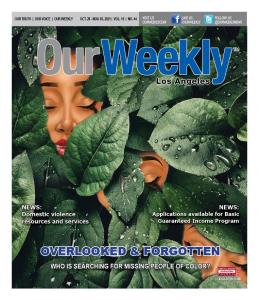
The missing person case of 22-year-old Gabby Petito became an “above-the-fold” trending topic almost overnight. At the same time, anger has cropped up among individuals on social media drawing attention to the countless missing men, women and children of color whose cases have largely gone under reported locally and nationally.
There’s a considerable list over the last few decades of “missing White women” who have drawn national attention, among them Natalee Holloway, Laci Peterson, Chandra Levy, Lauren Spierer and Holly Bobo. These cases were splashed across the headlines and were the focus of morning talk and true crime shows.
Similar tragedies are sadly commonplace in a country where hundreds of thousands of people go missing every year. And yet the discovery of Petito’s body has triggered a staggering amount of interest. The disappearances of young White females—especially those who are relatively wealthy and fit traditional stereotypes of being attractive—receive far more media coverage than their minority counterparts.
In images that Petito and her boyfriend, Brian Laundrie, shared on social media, they were all smiles, barefoot in a canyon or marveling at the ochre of rocks at state and national parks. The quixotic disconnect between how the public viewed Petito’s road-tripping life and the tragedy of what occurred, helped to fuel the fascination.
At roughly the same time frame that Petito went missing, 16-year-old Leivy Mariela Rodas disappeared from Londonderry Township, Pa. The Pennsylvania State Police began a search, of course, but the case languishes in obscurity because one girl was White, and the other is one of color.
Daniel Robinson, a 24-year-old geologist from Tempe, Ariz., went missing June 23 after leaving his worksite in Buckeye. The case remains unsolved and, to date, there are no clues that explain why Robinson’s vehicle was found in a ravine just miles away from his job.
Some 46 percent of missing person cases in 2020 were not White, based on FBI statistics. Yet the news covers only about one-fifth of missing persons cases involving minorities, according to a 2016 analysis by Northwestern University. Such findings would lead to the curious complaint of “missing White woman syndrome,” a phrase coined by the late PBS anchor Gwen Ifill. It’s the tendency of media and national attention to focus solely on missing White women more than women or men of color.
“No one is looking for us,” said MSNBC journalist Joy Reid. “It goes without saying that no family should ever have to endure that kind of pain, and the Petito family certainly deserve answers and justice. But the way that this story has captivated the nation has many wondering why not the same media attention when people of color go missing?”
Some have explained the media’s focus on missing White women by pointing to society’s apparent obsession with “damsels in distress.” People are riveted by cases in which a young beautiful—and often blonde—girl has apparently been abducted by an evil-doer and is in need of rescue.
A shady side of war: The death of ‘Captain Midnight’
Nov. 10, 2021
BY GREGG REESE
OW CONTRIBUTOR

Fifty years later, a wartime killing haunts the survivor.
It was Dec. 22, 1967. Christmas rapidly approached. As Private First Class Calvin Touchstone and a planeload of Army recruits sped westward, the holidays were a time of apprehension.
Leaving the States for a foreign country right before Christmas is depressing enough. Arriving before Christmas in a war zone is a whole other affair. Upon their arrival in Saigon, the army wasted no time to allow the malady of homesickness to sit in, and within two hours they were loaded into a caravan of vehicles for the trek to their new “home,” in the hamlet of Cu Chi 35 miles northwest.
Upon their arrival, they witnessed a ”Huey” helicopter land, its interior lined with what they immediately recognized as OD Green for “body bags,“ heavy-duty rubberized fabric pouches for the storage and transportation of servicemen killed in action. The reality of war hit home.
Cu Chi served as the base camp for the 25th Infantry Division “Tropic Lightning.” As such, it housed some 25,000 troops, including the three-quarter (3/4) Cavalry Squadron to which Touchstone had been assigned. Modern cavalry units trace their lineage back to the troops who fought the Indians in the American West, updated to include tanks and tracked vehicles, along with an assortment of helicopters.
Race relations at Cu Chi mirrored those back in the states, albeit with a twist. Soldiers of color could experience unduly harsh punishment for minor infractions, be overlooked for awards and decorations, and little or no advancement in terms of promotions.
One figure stood out. The lone Black officer within the squadron was known as “Captain Midnight.”
Imposing at 6 feet, 2 inches, James Barrington Westbrook earned this nickname (in a non-derogatory way) due to his dark complexion. As befitting a responsible commander of Bravo Troop, he saw that everyone was treated fairly and promoted regardless of race.
All of his subordinates were not pleased with this Howard University graduate and member of the Omega Psi Phi Fraternity, however. The Cadre of racist sentiments usually had roots within the Midwest and Southern United States. Whites who had no such basis would tell their compatriots of color about snide remarks concerning this officer who dared to attempt to level the playing field.
During the Tet offensive, on Aug. 25, as elements of the 3/4 Cavalry were out searching for the enemy near a French Rubber Plantation at Filhol. Westbrook reportedly dismounted from his track to personally direct his men. At some point he was hit by gunfire.
Touchstone was in his own track, monitoring the progress when news of the Captain’s death came over the teletype. Later in the day he encountered soldiers from Bravo troop who told him Westbrook had been killed. Still later, rumors circulated that he’d been executed by friendly fire. From his own troops.
“Them White boys killed him,” the rumors spread. “They shot him in the back. Twice.”
Eventually an assembly was held, as the top brass announced Westbrook’s passing, then reiterated warnings of repercussions to anyone voicing disrespect to the fallen officer.
For the rest of Touchstone’s tour, the atmosphere remained tense-but didn’t get any worse. No inquiries or investigations were ever made. A search of Westbrook’s name on Vietnam related websites lists him as “Killed in Action by Small Arms Fire.”
‘Holiday Blues’ for yet another season
Dec. 2, 2021
BY LISA OLIVIA FITCH
EDITOR IN CHIEF
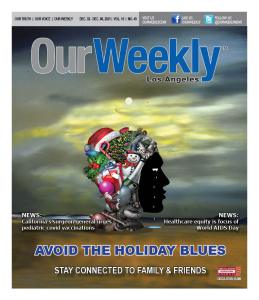
County Supervisor Kathryn Barger was on hand at a recent virtual seminar hosted by Ethnic Media Services, joining a host of experts in a discussion of how L.A. County residents can cope with the “holiday blues.” She noted that it is especially difficult to keep mentally resilient during this, a second pandemic-era holiday season.
“Many individuals are facing multiple losses—having lost family members and friends,” she said, noting that the pandemic has meant significant changes to daily life routines for everyone, making the everyday more challenging and impacting one’s disposition.
“Coming into the holidays we need to embrace those who are struggling,” Barger said. “The isolation has definitely taken its toll…I think we all go through it. It doesn’t mean that you’re weak, it means that you are strong.”
Barger explained that because depression is the number one issue facing people, one of her greatest passions and priorities is to create solutions to support community mental health. There are many services available through various county departments and she hopes to help break the stigma of mental healthcare and remind residents that it is OK to ask for help.
“Mental health stress doesn’t discriminate,” Barger said. “The holiday blues can affect anyone of any background.”
Dr. Jonathan Sherin, director of LA County’s Department of Mental Health (DMH), agreed and recommended that citizens concerned for their own mental health or that of a loved one should call the 24-hour DMH helpline at (800) 854-7771 for real-time emotional support. He expects the number of calls to go up during the holidays.
“If you see somebody not doing well, reach out to them,” he said.
Additionally, the county has “headspace” and “I prevail” app-based paradigms which offer free web-based, confidential, anonymous treatments—tech solutions that the DMH is leveraging to deal with the large-scale pandemic that is impacting everyone’s mental health.
“Clearly covid has shocked the entire world for a lot longer than anyone could have expected,” Sherin said, noting that additional variants, including the atmosphere of social unrest, global warming and a number of other factors have created a sense of existential crisis for some.
“It’s critical to stay connected with ourselves, loved ones, friends and neighbors,” he said. “We have to listen to each other. Now is the time to recognize how interconnected we are.”
Sherin added that it is important to allow each other to have opinions and be respectful of those opinions. Additionally, small, random acts of kindness, even those as small as letting another driver into your lane, or opening a door for another can make one feel better about oneself and make others feel good because they are being recognized.
“Now is the time to actively listen and be tolerant,” Sherin said. “If family members are not comfortable with those who are not vaccinated, that’s their right and they can state that.”
Sherin recommended having healthy dialogues—discussions about vaccines and masks before family holiday gatherings, stating one’s parameters for safety and listening to the ideas of others. He said that the lack of autonomy, when one is told what to do and what not to do, can be challenging.
“It’s a part of us learning to deal with our interdependence,” Sherin said, stressing the need to engage with each other and calmly talk through problems, being respectful and caring toward one another, even though conflict is the norm in times of serious stress. “Listen like you haven’t before.”


